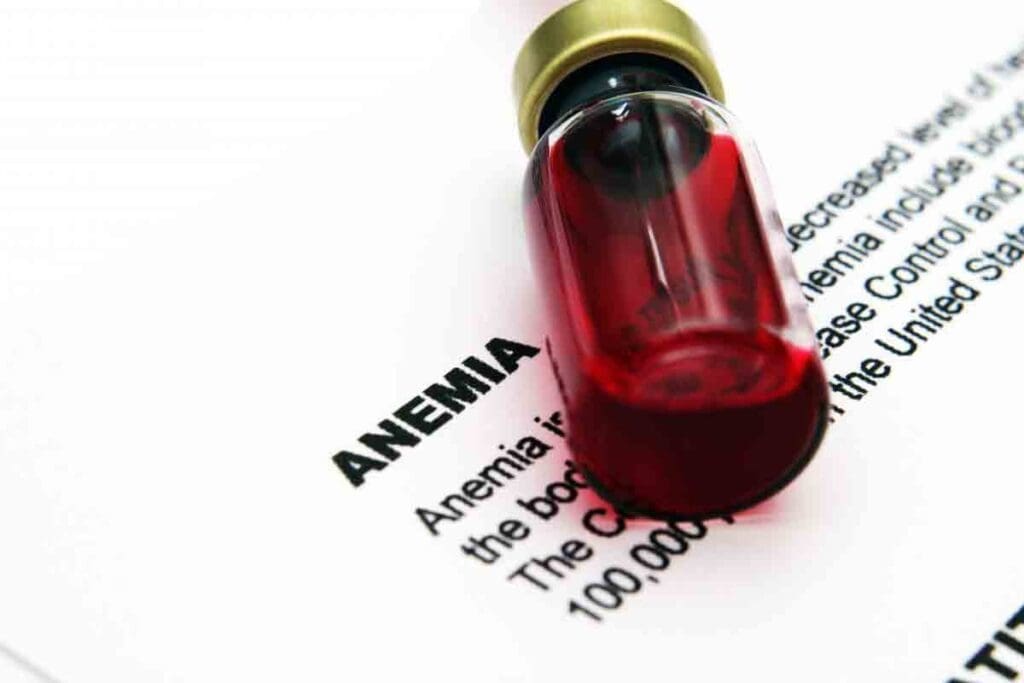Last Updated on November 20, 2025 by Ugurkan Demir

Anemia happens when your body doesn’t have enough healthy red blood cells to carry oxygen. Most cases are mild and can be managed. But severe or untreated cases raise an important question — can you die of anemia? Yes, if left untreated, it can become life-threatening.
At Liv Hospital, we know how serious anemia can be. We focus on early diagnosis and timely medical care. Our patient-centered approach, guided by international healthcare standards, helps reduce the risk of severe anemia and improve long-term health.

Anemia is a condition where the body lacks enough red blood cells or hemoglobin. Hemoglobin is a protein that carries oxygen. This lack of oxygen can cause fatigue, weakness, and shortness of breath.
When the body doesn’t get enough oxygen, it can feel tired, weak, and have trouble breathing. The severity of these symptoms depends on the cause and how severe the anemia is. Mild cases might not show symptoms, but severe cases can really affect daily life.
There are many types of anemia, each with its own cause:
Anemia is a big health problem worldwide. The World Health Organization (WHO) says about 1.62 billion people have anemia. It’s a major public health issue.
| Region | Prevalence of Anemia |
| Global | 1.62 billion people |
| United States | Approximately 3.5 million people |
Knowing about anemia’s types and how common it is helps in finding better treatments and prevention. Recognizing the risks and symptoms early can help people get the care they need. This can greatly improve their quality.

It’s important to know the risks of anemia for both patients and doctors. Anemia happens when there are not enough red blood cells or hemoglobin. If not treated, it can cause serious health problems.
Anemia is a big worry worldwide. In the U.S., there were 5,928 deaths linked to anemia in one year. This shows how vital it is to manage anemia well.
| Category | Number of Deaths | Percentage of Total Deaths |
| Total Anemia-Related Deaths | 5,928 | 100% |
| Underlying Cause | 3,014 | 51% |
| Contributing Cause | 2,914 | 49% |
The chance of dying from anemia depends on several things. The type and how severe the anemia is matter a lot. For example, sickle cell anemia and aplastic anemia are more dangerous. How bad the anemia is also affects the risk.
Anemia can be the main reason for death or just add to other health issues. If it’s the main cause, it directly leads to death. If it’s a secondary cause, it makes other health problems worse, leading to death.
Knowing these details helps us see why managing anemia is so important. It helps prevent serious and even fatal outcomes.
Severe anemia can cause serious health problems. If not treated, it can lead to life-threatening issues. These problems can greatly reduce a person’s quality of life and, in severe cases, be fatal.
Severe anemia puts extra strain on the heart. This is because the heart has to work harder without enough red blood cells. This can lead to heart failure, where the heart can’t pump enough blood.
It can also cause irregular heartbeats and increase the risk of heart attacks.
Heart failure is a major concern with severe anemia. Heart failure is a leading cause of death in such cases. The heart strain can cause cardiomyopathy and angina.
| Cardiovascular Complication | Description | Risk Factor |
| Heart Failure | The heart’s inability to pump enough blood | High |
| Arrhythmias | Irregular heartbeats | Moderate |
| Heart Attack | Damage to the heart muscle due to a lack of blood flow | High |
Severe anemia can cause organs to fail due to a lack of oxygen. This can damage vital organs like the kidneys, liver, and brain. Organ failure can significantly increase the risk of death in severe anemia patients.
The lack of oxygen can cause acute kidney injury and liver dysfunction. In severe cases, it can lead to multi-organ failure, a condition with a high mortality rate.
Severe anemia can weaken the immune system. This makes people more likely to get infections. The body’s ability to fight off pathogens is impaired, leading to potentially life-threatening infections.
Patients with severe anemia are at a higher risk of infections due to immune system dysfunction. This can lead to sepsis, a potentially fatal condition if not promptly treated.
It’s important to know the risks of different anemia types. Some types can cause serious health problems and even death if not treated properly.
Sickle cell anemia is a genetic disorder that affects how red blood cells are made. These cells can get stuck in blood vessels, causing pain and serious health issues. People with sickle cell disease usually live about 54 years. Thanks to better medical care, more people are living longer, but they need close monitoring and treatment.
Thalassemia major, or beta-thalassemia, is a severe anemia that needs regular blood transfusions. It can cause iron overload and other problems if not managed well. With better treatments like iron chelation therapy, more people are surviving. But, it’s a serious condition that needs ongoing care.
Aplastic anemia is a rare and serious condition where the bone marrow doesn’t make enough blood cells. This can cause severe infections, anemia, and bleeding problems. It can be caused by toxins, some medicines, and viruses. Treatment might include immunosuppressive therapy or bone marrow transplantation.
Myelodysplastic syndromes (MDS) are disorders where blood cells are not made right. MDS can turn into acute myeloid leukemia (AML), a more aggressive blood cancer. How likely someone is to die from MDS depends on the type and other factors. Treatment can range from supportive care to chemotherapy and stem cell transplantation.
We know these high-risk anemia types need careful management and treatment to avoid fatal outcomes. By understanding the risks and complications of each, healthcare providers can create effective treatment plans to help patients.
It’s important to know the warning signs of severe anemia to avoid serious health issues. Anemia happens when there are not enough red blood cells or hemoglobin in the blood. This can lead to serious problems if not treated quickly. We’ll look at the key symptoms that mean you need to see a doctor right away, focusing on both sudden and ongoing severe anemia.
Severe anemia shows itself through several urgent signs. These include:
Doctors say it’s vital to spot these symptoms early. Seeking medical help right away is critical if you or someone you know is showing these signs.
Knowing when to get medical help for anemia symptoms is key. If you notice any of these, don’t wait to get help:
Acting quickly can greatly improve outcomes for severe anemia. It’s important to watch your body’s changes and get medical help when needed.
Knowing the difference between acute and chronic severe anemia is important for the right treatment. Acute severe anemia shows sudden and severe symptoms, like:
Chronic severe anemia, on the other hand, has more gradual symptoms, such as:
A medical expert notes, “Distinguishing between acute and chronic anemia is key for the right treatment.” Both need medical care, but the urgency and treatment type differ.
“The key to managing anemia effectively lies in early detection and appropriate treatment. Recognizing the symptoms is the first step towards preventing severe outcomes.”
Anemia is a big problem for the elderly, pregnant women, and children. It makes them more likely to die. We’ll look at how anemia affects these groups and the dangers it brings.
Anemia is a big risk for older adults. It can lead to heart problems, brain decline, and less physical strength. These issues can increase the chance of death.
Research shows that anemia in the elderly is linked to chronic diseases. These include kidney disease, cancer, and inflammation. It’s important to manage anemia in older adults to lower death risk.
Pregnant women with anemia face serious health risks. These include preeclampsia, early labor, and heavy bleeding after birth. Anemia can also harm the baby, leading to low birth weight and early birth.
It’s key for pregnant women to get regular prenatal care. This includes checking for anemia. Iron supplements and other treatments can help manage anemia during pregnancy.
Severe anemia in kids can cause big problems. It can harm brain development, make them more likely to get sick, and even be fatal. In places with lots of malaria and other diseases, anemia is a big reason for child deaths.
It’s important to find and treat anemia in kids early. This includes giving them iron, teaching them about healthy eating, and treating the cause.
People with chronic diseases like kidney disease, cancer, and HIV/AIDS are more likely to get anemia. Anemia can make these conditions worse, leading to worse health and a higher death risk.
Managing anemia in those with chronic diseases needs a full plan. This includes treating the disease, giving iron, and using other supportive treatments.
It’s important to know how anemia affects life expectancy. Chronic anemia can greatly impact a person’s quality of life and how long they live.
Chronic anemia can come from many causes, like chronic diseases, not enough nutrients, or genetic disorders. The effect on life expectancy depends on the cause, how severe the anemia is, and how well it’s treated.
People with sickle cell anemia or thalassemia major face big challenges. Thanks to new treatments, their outlook has improved. But they need ongoing care to avoid serious problems.
Living with anemia is more than just managing the condition. It’s about feeling good overall. Fatigue, a common symptom, can make everyday tasks hard.
Managing anemia well means treating the cause and the symptoms. This might include changing your diet, taking iron, or other treatments based on your anemia type.
Long-term health for people with anemia depends on several things. These include the cause of the anemia, how well treatment works, and if there are any complications. Regular check-ups and care are key to managing the condition and avoiding long-term harm.
Untreated or severe anemia can harm the heart. The heart has to work harder without enough red blood cells. This can lead to heart failure or other heart problems if not managed.
We know managing anemia is a big job. But, with the right care and a proactive plan, people with anemia can live better lives. They can also potentially live longer.
Preventing anemia-related deaths starts with quick and correct treatment. Anemia can lead to serious problems if not treated properly. But with the right medical care, the danger of death drops a lot.
For severe anemia, quick action is key to avoiding serious problems. Emergency treatments include giving oxygen, fluids, and blood transfusions if needed.
Healthcare teams must quickly figure out the cause and start treatment. This might involve many doctors, like hematologists.
Blood transfusions are key for treating anemia, mainly when there’s a lot of blood loss. Transfusions boost oxygen to organs, lowering the risk of organ failure.
Doctors decide on transfusions based on several things. These include the patient’s hemoglobin levels, symptoms, and overall health. Transfusions are usually considered when hemoglobin is too low or when oxygen delivery is poor.
There are many treatments for different anemias. For iron-deficiency anemia, iron supplements are often used. Vitamin B12 injections are needed for pernicious anemia.
Surgery is sometimes needed to treat the cause. For example, surgery might be needed to stop chronic bleeding or fix genetic issues with red blood cell production.
Splenectomy, or removing the spleen, is done for some anemias. This includes hereditary spherocytosis or autoimmune hemolytic anemia, where the spleen is too active.
Stopping anemia from getting worse is key to staying healthy. Knowing how to prevent anemia can help avoid serious problems. It’s important to take steps to keep anemia from becoming severe.
Checking for anemia regularly is very important. We suggest getting blood tests often. This is true for pregnant women, kids, and people with long-term illnesses.
| Population | Recommended Screening Frequency |
| Pregnant Women | At least once during pregnancy |
| Children | During routine check-ups |
| Individuals with Chronic Diseases | As advised by their healthcare provider |
Changing your diet and lifestyle can help prevent anemia. Eating more iron and vitamin C is good. Also, avoid things that block iron absorption.
“A well-balanced diet is key to preventing anemia. Ensuring adequate intake of essential nutrients can significantly reduce the risk of developing anemia.”
-Hematologist
It’s important to manage conditions that can cause anemia. Treating chronic kidney disease, stomach problems, and infections is critical.
If you’re at risk or have anemia, seeing a hematologist is important. Look for a specialist if your anemia is severe, you have a family history, or treatments aren’t working.
Key Takeaways:
It’s key to understand and manage anemia to avoid death from it. Anemia can be treated with the right diagnosis and care. We’ve talked about the different types of anemia, how common they are, and their dangers.
Managing the risk of death needs a full plan. This includes quick diagnosis, the right treatment, and lifestyle changes. By knowing about anemia risks and acting early, we can lower the chance of serious problems. We need to spread the word about anemia and its dangers, so we can catch it early and manage it well.
With the right care, people with anemia can live full and happy lives. We urge everyone to look after their health and get help if they show signs of anemia. This way, we can lower the risk of death from anemia and improve health for all.
Yes, severe or untreated anemia can lead to life-threatening complications and potentially cause death.
The risk of dying from anemia depends on its cause, severity, and management. Certain types, like sickle cell anemia or aplastic anemia, carry higher mortality risks.
While iron deficiency anemia is typically not fatal if treated, severe cases can lead to serious complications. This is true for vulnerable populations like pregnant women or those with chronic diseases.
Chronic anemia can impact life expectancy, especially if it’s caused by an underlying condition not well-managed. The effect on lifespan varies by type and severity of anemia.
Severe anemia can lead to cardiovascular complications, organ failure, and immune system compromise. These can be life-threatening if not properly managed.
Anemia can be listed as a primary or secondary cause of death, depending on the circumstances. Often, it is a contributing factor to mortality, not the sole cause.
Regular screening, dietary and lifestyle modifications, managing underlying conditions, and timely medical intervention can prevent anemia from becoming severe.
Symptoms like severe fatigue, chest pain, shortness of breath, and dizziness require immediate medical attention. They can indicate acute or severe anemia.
Yes, vulnerable populations like the elderly, pregnant women, children, and patients with chronic diseases are at a higher risk of fatal complications from anemia.
Timely and appropriate treatments, including emergency interventions, blood transfusions, medications, and surgical options, can prevent fatal outcomes from anemia.
While rare, severe iron deficiency anemia can lead to life-threatening complications if left untreated or poorly managed.
Anemia itself is not always deadly, but severe or untreated cases can lead to serious and potentially fatal complications.
Anemia can contribute to mortality, mainly if it is severe, untreated, or caused by an underlying condition not well-managed.
Subscribe to our e-newsletter to stay informed about the latest innovations in the world of health and exclusive offers!